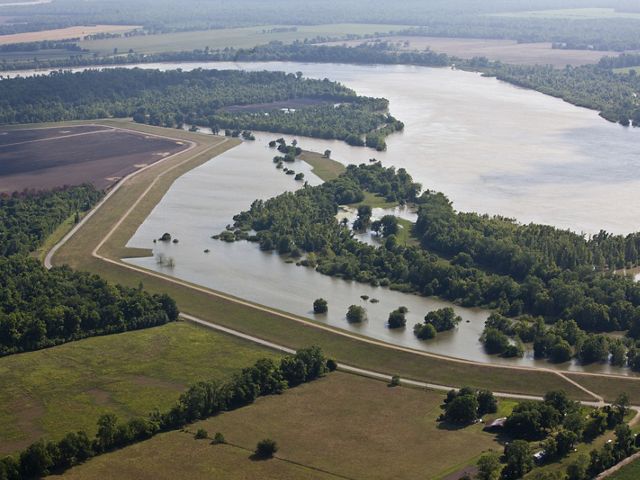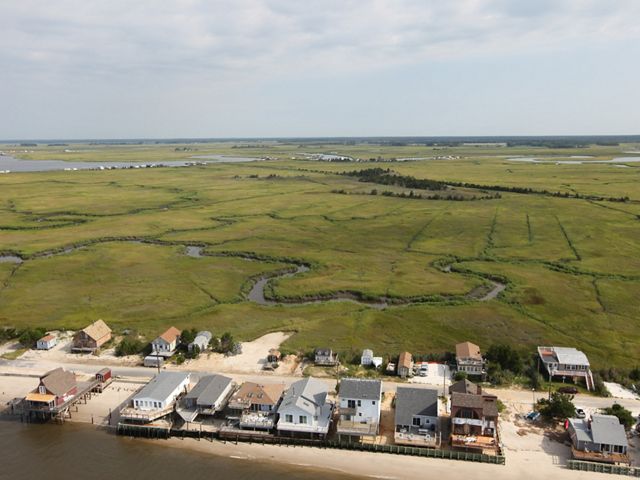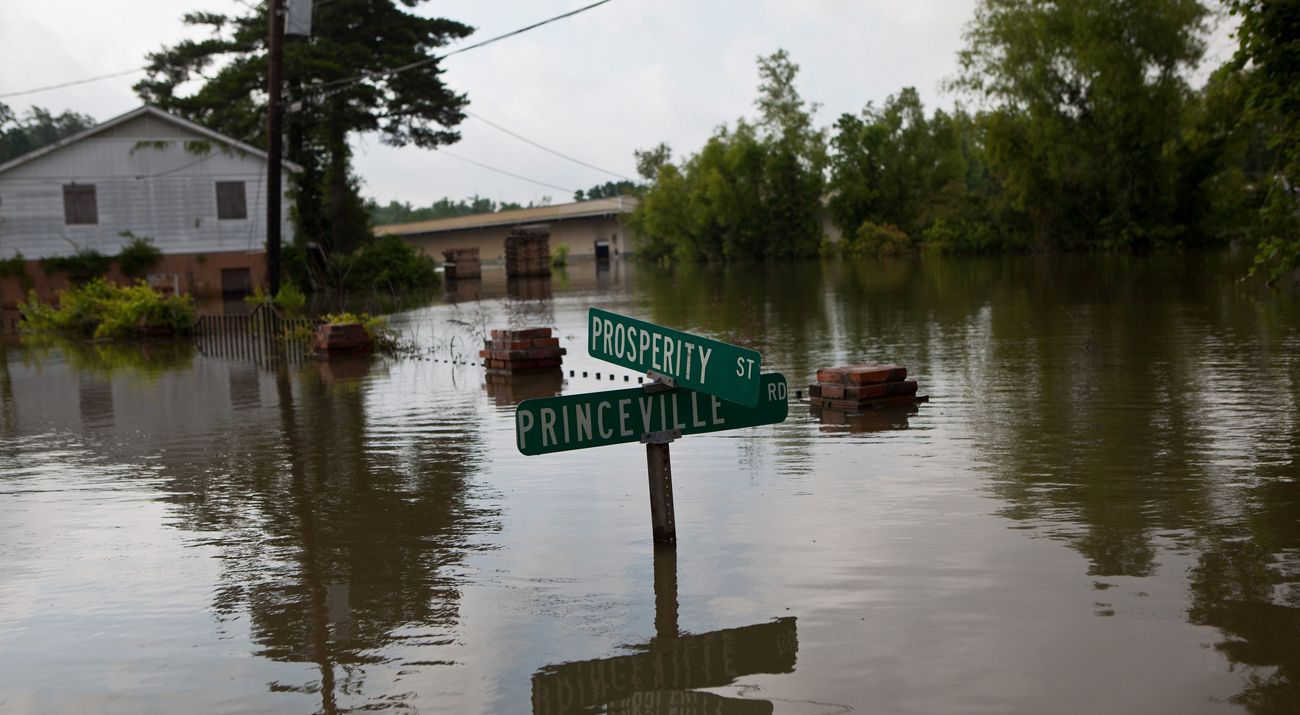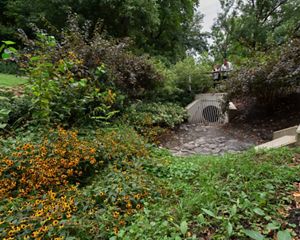How Nature Can Help Reduce Flood Risks
Conservation is an economical way to avoid costly flood damages. In some areas the benefits are 5x the cost.
2019 was officially the wettest year on record in the United States. Fueled by a changing climate and warmer weather, many U.S. citizens suffered from costly and historic flooding disasters. In the spring, flooding on the Missouri River and in North Central states caused $10.8 billion in damages. Then, as floodwaters flowed downstream and heavy rains continued into the summer, flooding in the Midwest and along the Mississippi River caused an additional $6.2 billion in damages. And, combined, Hurricane Dorian and Tropical Strom Imelda resulted in some $6.6 billion in damages in 2019, most of which was caused by flooding.
But 2017 wasn’t any better, when 16 separate billion-dollar weather events in the U.S. caused cumulative damages of $306.2 billion, breaking the previous record of $214.8 billion in 2005. Unfortunately, flood damages along rivers are worsening, as many of the nation’s most costly floods have occurred over the past 10 years, according to Floodlist.com. Not surprisingly, the taxpayer-supported National Flood Insurance Program is now more than $20 billion in debt.
Quote: Anna Brown
It’s time to rethink the way we plan and prepare for flooding.
“It’s time to rethink the way we plan and prepare for flooding,” says Anna Brown director of The Nature Conservancy’s Climate Adaptation Strategy. “Too often the role that nature can play in reducing flood risks is overlooked or undervalued. Nature-based solutions—such as reconnecting floodplains to give rivers more room during floods or restoring reefs, marshes or dunes that can protect coastal communities during storms—can also help improve water quality, provide prime wildlife habitat, enhance recreational opportunities, and produce related economic and social benefits.”
A Conservation and Flood Prevention Win-Win
In January 2009, Washington was drenched by a storm that also melted the winter snowpack, causing rivers west of the Cascades to flood. In and near the town of Orting, 26,000 residents were ordered to evacuate before the Puyallup River topped its levees.
Orting’s levee system, which constricted the river into a straightened channel, had been battered by floods since the 1990s, and the county could not repair the levees as quickly as they were being damaged.
After the 2009 flood, a partnership between TNC and the State of Washington made drastic changes in the basin. “We got the flood control folks, who historically relied on grey, engineered infrastructure, together with the conservation folks, who relied on protecting and restoring green infrastructure, to work together to build sustainable hybrid solutions,” says Bob Carey, director of the Conservancy’s Floodplains by Design program.

The partnership helped residents move out of harm’s way by buying properties that were inside the floodplain. New levees were rebuilt farther back than the old ones, on average tripling the width of the floodplain. The results were impressive. In 2014 the river flowed at almost the same rate as the devastating 2009 flood, but the town stayed dry. In addition to improving flood protection, the project restored natural habitat that promotes salmon recovery and helps generate tourism revenue.
Other examples where TNC has worked with partners to demonstrate the benefits of giving rivers more room include the Mollicy Farms Unit of the Upper Ouachita National Wildlife Refuge in Louisiana and TNC’s Emiquon Preserve in Illinois.
The Value of Nature-Based Solutions along Our Rivers
Scientific research has shown that a one-acre wetland can hold about three acre-feet of water (or 1 million gallons) during flood events, which is then released after the rains subside.
A new study by TNC and partners answers an important question: “What would cost American taxpayers more? Paying now to protect undeveloped areas that are likely to flood in the coming decades? Or, allowing development to proceed based on current projections and paying for subsequent flood damages when they inevitably occur?”
The answer? The study, published in Nature Sustainability, identified an area roughly the size of Colorado in “100-year” floodplains where conservation would be an economically sound way to avoid future flood damages. And for just over 21,000 square miles of this area, the benefits are at least five times the cost, meaning that a dollar invested in floodplain protection today returns least $5 in savings from avoided flood damages in the future.
Restoring Our Coasts
- The Congressional Budget Office estimates that, on average, hurricanes cause $28 billion in damage each year.
- Unfortunately, Americans continue to move into harm’s way. Since 1970, 35 million more people have moved to high-risk areas along our coasts, potentially placing themselves in the direct path of devastating storm surges. (Source.)
Nature-Based Solutions Stand Strong Against Superstorm Sandy
When Hurricane Sandy hit the Atlantic Coast in 2012, it inflicted nearly $70 billion in damage, making it was the second-costliest hurricane in U.S. history until surpassed by Hurricanes Harvey and Maria in 2017. Sandy hit New Jersey particularly hard.
“The area around Cape May in particular fared very well,” says Adrianna Zito-Livingston, TNC’s coastal projects coordinator in New Jersey. “We contribute that to TNC’s restoration work here.”
After decades of deterioration, TNC restored in 2007 the South Cape May Meadows Preserve, which sits between the ocean and dozens of homes.
“There had been a lot of dune restoration and beach re-nourishment,” Zito-Livingston says. “So the beach was wide enough, the dunes tall enough, and the freshwater wetlands held enough water that we didn’t see a lot of coastal flooding, and we didn’t see any dunes wash over.”
Today the restored preserve serves as a model for the protective role of nature, while providing year-round wildlife, economic and social benefits.
The Value of Nature-Based Solutions along Our Coasts
Recent research has shown that:
- Coastal marshes can reduce wave energy by over 50 percent.
- Mangroves can reduce the height and energy of waves by up to 66 percent.
- Coastal wetlands provide storm protection valued at $23.2 billion every year in the U.S.
- Coral reefs provide $1.8 billion in flood protection benefits each year.
- Nature-based solutions are among the most cost-effective ways to protect against coast flooding. Every $1 spent to restore wetlands and reefs results in $7 of direct flood reduction benefits.

The Path to a Better Future
Recommendations for Nature-Based Solutions. To harness the power of nature and help communities overcome the growing threats of floods, we should:
- Invest in nature-based solutions. When planning for flood protection, nature-based solutions should be considered when new or rebuilt manmade infrastructure is also considered. Disaster relief funds provide prime investment opportunities for nature-based solutions.
- Improve and update manmade infrastructure along our rivers and coasts. In its 2017 Infrastructure Report Card, the American Society of Civil Engineers gave the nation’s dams and levees a “D” rating. With the right investments, we can use modern science to improve infrastructure in ways that work with nature, not against it.
- Increase awareness. We must do a better job of increasing flood risk awareness through:
- Using science and up-to-date climate projections to improve flood maps.
- Requirements that disclose the history of flood insurance claims of properties to help prospective buyers better understand their flood risks.
- Community outreach that encourages flood risk assessments and less risky development.
- Flood-proofing of existing properties and rules that discourage further development in flood-prone areas.
- Modernize policies. We should seek policies that provide incentives for communities to reduce flood risk and guide development away from risky areas.
- Reform the National Flood Insurance Program. The National Flood Insurance Program is designed to discourage development in high flood risk areas. But in many FEMA mapped floodplains, places that could have provided natural buffers during floods have often been developed.
- Congress and the Executive Branch should reinstate the Federal Flood Risk Management Standard, which creates common-sense rules to help protect communities from floods.
- It is critical to ensure the Clean Water Act protects wetlands, waterways and natural floodplains. The Clean Water Act helps ensure development avoids, minimizes and mitigates wetland and floodplain impacts, thus maintaining their flood storage and water filtration capacity.
More Resources
- A Tale of Two Floods - Video comparing Mississippi River floods of 1927 and 2011.
- Animated Video - Shows how nature-based solutions can complement manmade infrastructure, like levees, locks and dams.
- Scientific Report - The Value of Coastal Wetlands for Flood Damage Reduction in the Northeastern USA.
- Community Incentives for Nature-Based Solutions
- Strategic Property Buyouts to Enhance Flood Resilience (.pdf)

